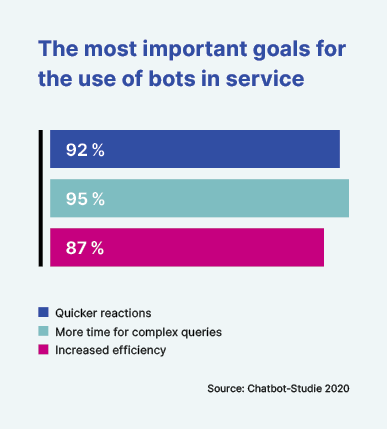Based on the recent CCW Market study, chatbots are one of the highest executive priorities for customer service in 2019. Industry leaders believe that chatbots are an innovative way to automate service inquiries, improve simple customer request and deliver an outstanding overall customer journey. Though it remains on top of the priority list, many companies struggle to get started with chatbots. Competitive pressure often leads companies to deploy chatbots too quickly which often leads to disappointing results based on inadequate planning and implementation. This article shares some best practices on how to get started and how to develop an internal business case to successfully approach chatbots for your current and future customer service.
What are Bots for Customer Service?
First off, let’s define what exactly chatbots are as they can take many forms for the end user.
A bot is usually described as a virtual agent that is based on technology to automatically guide a customer through a process, request or inquiry. The two most common bots are currently voice and chatbots. Voice bots primarily focus on speech analytics and Natural Language Processing (NLP). Based on an oral conversation, voice bots analyze the request and either guide a customer through a process or provide the right solution. This bot can be integrated into a telephone system or into digital assistants such as Alexa or Siri.
 Chatbots are text-based bots. In comparison to voice bots their focus is on written conversation with a customer. Usually this text-based exchange takes place within a chat or on social media. This makes it harder to automate, because emotions are usually easier to sense within a regular spoken conversation. It is paramount that this hurdle is considered for bot deployment.
Chatbots are text-based bots. In comparison to voice bots their focus is on written conversation with a customer. Usually this text-based exchange takes place within a chat or on social media. This makes it harder to automate, because emotions are usually easier to sense within a regular spoken conversation. It is paramount that this hurdle is considered for bot deployment.
This article will primarily focus on chatbots and outline a voice bot scenario in the last section.
Bot opportunities in Customer Service
One of the essential questions is which processes are best suited for chatbots. We mentioned earlier that a chatbot provides a non-verbal conversation which makes emotional intelligence nearly impossible. The human touch remains paramount for critical customer requests such as potential churn or complaint management.
If chatbots are deployed in the wrong process, they can have a negative impact on both customer satisfaction and your net promoter score. To reach chatbots’ full potential, companies need to be smart and even a bit conservative in deciding where they want to initially deploy them. Even though chatbots often take low value work and repetitive tasks, the customer should still have a great experience.
Essentially, it’s important that “low value work” still warrants a ‘high value experience” (Brian Cantor, CMP)
 Read more about Chatbots in our White Paper:
Read more about Chatbots in our White Paper:

Where a chatbot drives value into customer service
Here are three scenarios where chatbots usually make sense
1. When Accuracy matters
Whenever the accuracy of information matters most, chatbots are a good choice. If a chatbot gathers for example information for complex forms or financial policies, customers tend to prefer non-verbal and non-real time communication. This allows them time to double-check relevant information such as credit card or social security information.
In addition, it avoids constantly being put on hold during conversations with an agent. On the other hand, agents don’t need to go through complex forms and gather information field by field. It allows them time to focus on more complex inquiries, where human intelligence is required.
2. Commercial Transactions
Another area to consider are commercial transactions. For example, a passenger wants to upgrade their upcoming flight. In that scenario a chatbot provides information and the conditions for the upgrade and requests the necessary information to complete the order. The customer doesn’t need to call and can make the upgrade at any time which is convenient to them.
The company can easily make a business case out of it – if a bot guides customers through commercial transactions, it generates revenue and supports the company’s growth without using human resources. B2C companies especially have many commercial transactions that can be automated and handled by chatbots.
3. Personal Information Customers prefer not to share with a Human Agent
Consider situations where a customer needs to share confidential and perhaps embarrassing information with a company. Perhaps they have medical issues or are in debt and need a consultation. A verbal conversation can get awkward because the other person on the line needs to sense the customer’s personal situation and might not be in the same emotional position. There is a risk that the customer feels uncomfortable sharing private information with a stranger on the phone.
But if a customer merely has to type to a chatbot, this situation can be avoided entirely by taking a human agent out of the process. This is a great example for a high-value customer experience that it still makes sense with bots.
How Chatbots Impact your Customer Service & Company Value
USU‘s own research, which surveyed over 150 experts in the industry about their goals using of chatbots showed that the top three priorities are:

Most companies want to use chatbots to automate inquiries and let agents focus on valuable and complex requests. This doesn’t necessarily mean that companies reduce existing FTE. Even though companies provide multiple customer touch points in a connected customer experience, call volume still tends to rise over time. One goal of a chatbot might be to maintain the current contact center headcount and use chatbots to offset rising call volume. Unallocated FTE can also be used to train the chatbot and make it more efficient. This not only improves the chatbot, but also provides additional job opportunities for agents.
The second goal is to react faster to customer requests. A chatbot performs 24x7 support, can handle multiple requests simultaneously and can probably solve the customer’s solution immediately (if deployed for the right process). A quicker reaction will increase customer satisfaction and the overall experience because no one wants to wait for an agent to pick up after a long work day. This helps boost customer satisfaction and your Net Promoter Score over time.
In addition, this overall customer service efficiency increase allows more time for complex requests (which will improve First Contact resolution rate) and make customers more satisfied because they will perform lass repetitive tasks. On a company level, chatbots can drive revenue (if deployed for commercial transactions) and boost your CSAT and NPS.
How to get started with Chatbots
There are some important points that you need to consider before you start a chatbot project:
1. Select the Right Process
The number one goal of a chatbot is happier customers. Don’t deploy chatbots for their own sake or purely to improve KPIs. Analyze your existing requests and try to understand for which requests customers you would rather have a non-verbal conversation or automated option.
2. Provide an Escape Route for Customers
Make clear that the chatbot is just an additional option and that customers always have the option of switching to a real person. For example, your opening line could be:
“Hey, I am a chatbot and am still learning. Just say “Agent please” to switch to a live agent at any time.”
Or if the bot is unable to provide an answer with high certainty, it can respond: “I’m not 100% sure about the answer here, should I transfer you to a live agent?”
Take away the fear that customers are stuck in this channel once they select it. In addition, ensure that once there is a handover, the bot provides the context and previous chat information for the real live person, so the customer is not forced to explain everything again.
3. Don’t Design your Chatbot with Technology in Mind
Deciding which workflows to automate and when, should be a technology and vendor independent process. At the risk of beating a dead horse here, your focus should be on adding value for the customer. The solution will then stem from that.
Once you have a clear plan of action, it’s time to begin evaluating vendors and software solutions. However, the first step shouldn’t be skipped because of previous decisions or current software selection.
4. Dedicate Time to Creating Quality Chatbot Content
Once you start designing chatbots, the technology should provide an easy WYSIWYG editor to edit and create content for the bot and to build dialogues. Ideally, your chatbot should be integrated with your existing knowledge base to use as a data source. This prevents having to create separate information for the bot and having to maintain things in multiple systems.
If dialogue creation requires developers, the project may take forever to go live.
How to Get Budget Allocated for Chatbots
Whether or not you have budget allocated, consider the following steps to secure project funding:
- Create a proof of concept: Choose a simple project and narrow it down to one domain to see if it works
- If successful, you reuse the results to ask for additional funding
- Use an agile approach – try all the options, constantly discarding what doesn’t work until reaching the results you need
If you don’t have a budget allocated, never fear! There is always non-technology related budget available. Try to sell the chatbot not as a technical solution but rather a company-wide efficiency improvement:
- If you are a growing company, chatbots can help you to stay up to speed and accelerate revenue
- If you’re struggling with costs: A chatbot helps customer service costs while improving efficiency
- A chatbot is a very easy way to handle volume in an economic and scalable way
No matter where you are currently, design a playbook for how to approach chatbots. Look for in-house resources. This doesn’t necessarily need to be a developer, but someone who provides competencies and is able to understand technology and help guide the process. If you decide to get an external vendor for the technology side: Ask them to build a proof of concept together with you.
Finally, pick the partner that works for you and your organization. It doesn’t need to be the cheapest or the best provider – pick the one that shares the same mindset.
Interested in chatbots for your business? Get in touch!
 More about Chatbots in our White Paper: Next Generation Chatbots
More about Chatbots in our White Paper: Next Generation Chatbots
